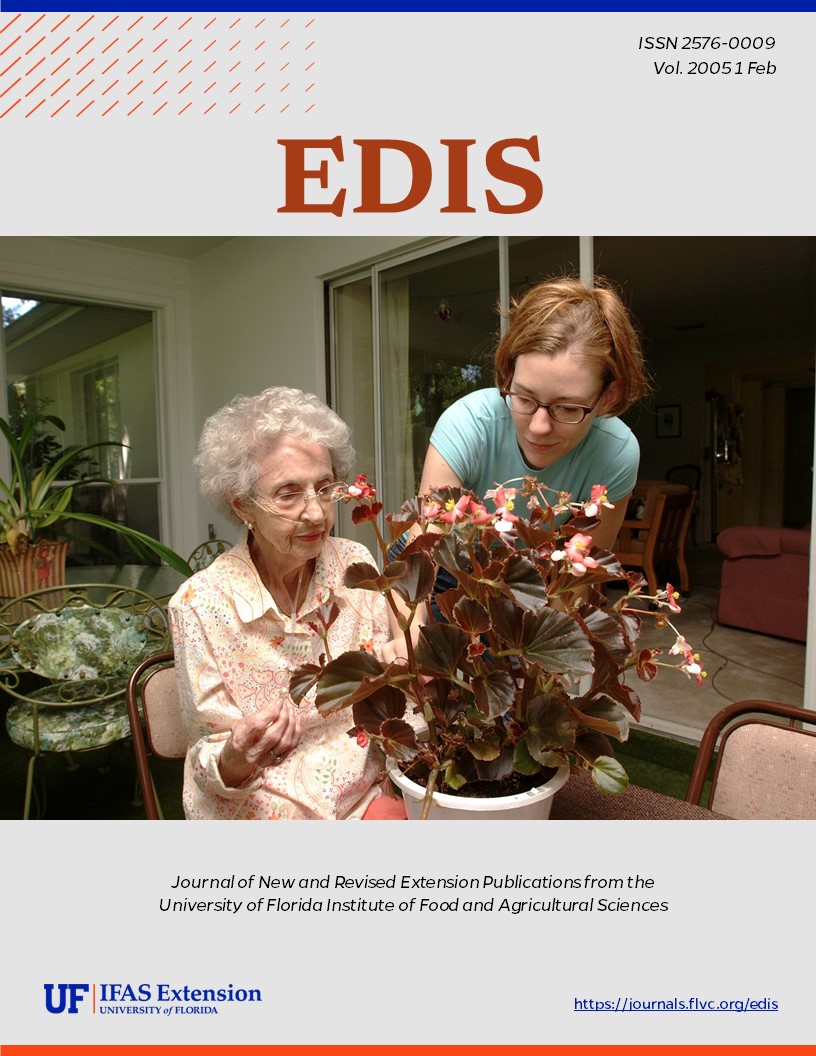Abstract
The brown recluse spider, Loxosceles reclusa Gertsch & Mulaik, is frequently reported in Florida as a cause of necrotic lesions in humans. For example, in the year 2000 alone, Loft (2001) reported that the Florida Poison Control Network had recorded nearly 300 alleged cases of brown recluse bites in the state; a subset of 95 of these bites was reported in the 21 counties (essentially Central Florida) under the jurisdiction of the regional poison control center in Tampa. This document is EENY-299 (originally published as DPI Entomology Circular 406), one of a series of Featured Creatures from the Entomology and Nematology Department, Florida Cooperative Extension Service, Institute of Food and Agricultural Sciences, University of Florida. Published: August 2003.
References
Anderson PC. 1982. Necrotizing spider bites. American Family Practicioner 26: 198-203.
Anderson PC. 1998. Missouri brown recluse spider: a review and update. Missouri Medicine 95: 318-322.
Banks N. 1904. The Arachnida of Florida. Proceedings, Academy of Natural Science, Philadelphia 56: 120-147.
Dame DA, Fasulo TR. (9 August 2002). Venemous Arthropods. Public Health Pesticide Applicator Training Manual. http://vector.ifas.ufl.edu/chapter_07.htm (23 June 2003).
Dominquez TJ. 2004. It's not a spider bite, it's community-acquired methicillin-resistant Staphylococcus aureus. Journal of the American Board of Family Practice 17:220-226. https://doi.org/10.3122/jabfm.17.3.220
Edwards GB. 1979. The giant crab spider, Heteropoda venatoria (Linnaeus) (Araneae: Sparassidae). Florida Department of Agriculture and Consumer Services (FDACS), Division of Plant Industry, Entomology Circular 205: 1-2.
Edwards GB. 1983. The southern house spider, Filistata hibernalis Hentz (Araneae: Filistatidae). FDACS, Division of Plant Industry, Entomology Circular 255: 1-2.
Edwards GB. 1989. The Florida false wolf spider, Ctenus captiosus (Araneae: Ctenidae). FDACS, Division of Plant Industry, Entomology Circular 319: 1-2.
Edwards GB. 1999. Insects of Medical and Veterinary Importance, in Halbert, S.E., ed., FDACS, Division of Plant Industry, Tri-Ology (Entomology Section) 38: 8.
Edwards GB. 2000. Insects of Medical and Veterinary Importance, in Halbert, S.E., ed., FDACS, Division of Plant Industry, Tri-Ology (Entomology Section) 39: 8.
Edwards GB. 2001. Insects of Medical and Veterinary Importance, in Halbert, S.E., ed., FDACS, Division of Plant Industry, Tri-Ology (Entomology Section) 40: 8.
Edwards GB. (13 August 2002a). Chilean recluse, Loxosceles laeta (Nicolet) (Araneae: Sicariidae) in Florida. Pest Alert. http://www.doacs.state.fl.us/pi/enpp/ento/loxoscel.html (26 June 2003).
Edwards GB. (16 September 2002b). Venomous Spiders in Florida . http://www.doacs.state.fl.us/pi/enpp/ento/venomousspiders.htm (23 June 2003).
Gertsch WJ. 1958. The spider genus Loxosceles in North America, Central America, and the West Indies. American Museum Novitates 1907: 1-46.
Gertsch WJ, Ennik F. 1983. The spider genus Loxosceles in North America, Central America, and the West Indies (Araneae, Loxoscelidae). Bulletin, American Museum of Natural History 175: 265-360.
Gertsch WJ, Mulaik S. 1940. The spiders of Texas. I. Bulletin, American Museum of Natural History 77: 307-340.
Gorham JR. 1968. The brown recluse spider Loxosceles reclusa and necrotic spiderbite - A new public health problem in the United States. Journal of Environmental Health 31, 8 pp.
Gorham JR. 1970. The brown recluse. United States Department of Health, Education, and Welfare, Public Health Service Publication 2062.
Hite JM., Gladney WJ, Lancaster JL Jr., Whitcomb WH. 1966. Biology of the brown recluse spider. University of Arkansas, Agricultural Experiment Station Bulletin 711: 1-26.
Loft K. 2001. DO NOT DISTURB. BayLife, Tampa Tribune, May 22, 2001.
Rees R, Shack RB, Withers E, et al. 1981. Management of brown recluse spider bite. Plastic Reconstructive Surgery 68: 768-773. https://doi.org/10.1097/00006534-198111000-00018
Vetter RS. (11 June 2003). Causes of necrotic wounds other than brown recluse spider bites. University of California, Riverside, Entomology Insect Information, Spiders and other Arachnids. http://spiders.ucr.edu/necrotic.html (27 June 2003).
Vetter RS. 2000. Myth: idiopathic wounds are often due to brown recluse or other spider bites throughout the United States. Western Journal of Medicine 173: 357-358. https://doi.org/10.1136/ewjm.173.5.357
Vetter RS, Edwards GB, James LF. 2004. Reports of envenomation by brown recluse spiders (Araneae: Sicariidae) outnumber verifications of Loxosceles spiders in Florida. Journal of Medical Entomology 41: 593-597. https://doi.org/10.1603/0022-2585-41.4.593
Vetter RS, Visscher PK. 1998. Bites and stings of medically important venomous arthropods. International Journal of Dermatology 37: 481-496. https://doi.org/10.1046/j.1365-4362.1998.00455.x
Weems HV Jr., Whitcomb WH. 1975. The brown recluse spider, Loxosceles reclusa Gertsch and Mulaik (Araneae: Loxoscelidae). FDACS, Division of Plant Industry, Entomology Circular 158: 1-2.
Wingo CW. 1960. Poisonous spiders. University of Missouri, Agricultural Experiment Station Bulletin 738: 1-11.
Unless otherwise specified, articles published in the EDIS journal after January 1, 2024 are licensed under a Creative Commons Attribution-NonCommercial-NoDerivs 4.0 International (CC BY-NC-ND 4.0) license.

